#Michael Mateas
Photo

#Façade#facade#funny#haha#lol#lmao#rofl#laugh#hilarious#image#soyjack#meme#pointing#two#you need to leave#leave#AI#Michael Mateas#Andrew Stern#Trip#Grace
13K notes
·
View notes
Note
Facade is made in the Petz engine?? That's honestly amazing. Do you have more info on this, or a wiki page or interview or smth? I'm fascinated by game engines being used for purposes other than what they're made for
SO i got this info from my friend Moon, but Facade was made by Andrew Stern, who was PF Magic's main designer and programmer, alongside Michael Mateas (didn't work for PF Magic as far as I know, but he DOES teach at my friend's college.)
There's also a lot of similarities. I don't entirely get the customizing Petz engine stuff, but my friend made this observation.

Another big piece of evidence?

facade cursor

petz cursor.
grace and trip are petz.
23 notes
·
View notes
Note
hiii could i get a playlist for matea? <3
hiiii matea here you go
M
A
T
E
A
2 notes
·
View notes
Text
Façade: An Experiment in Building a Fully-Realized Interactive Drama
Michael Mateas, Andrew Stern
If you click this link and click on the pdf button as shown in the picture, it'll take you to the full 24 page pdf.
https://www.semanticscholar.org/paper/Fac%CC%A7ade%3A-An-Experiment-in-Building-a-Fully-Realized-Mateas-Stern/a5d2af2a518e2c74761bdc3d976657ac48c9d2f8

1 note
·
View note
Text

Barbara Walters announces her retirement in 2014. (Lou Rocco/Getty Images)
Barbara Walters Dies at 93; News Anchor Broke the Boy’s Club of Network Television
— By Matea Gold | December 30, 2022 | Los Angeles Times
Barbara Walters, the first woman to break up the all-male club of network television anchors and one of the last remaining megastars in broadcast news who deftly coaxed world leaders and celebrities alike into revealing their secrets and deepest fears, has died.
“Barbara Walters passed away peacefully in her home surrounded by loved ones, She lived her life with no regrets. She was a trailblazer not only for female journalists but for all women,” Cindi Berger, Walters’ publicist, said in a statement to The Times.
Seemingly indefatigable though her long career, Walters died at 93.

(ABC Photo Archives/Disney General Entertainment Con)
Walt Disney Co. Chief Executive Bob Iger, Walters’ former boss, announced on Twitter that Walters died Friday evening at her home in New York.
“Barbara was a true legend, a pioneer not just for women in journalism but for journalism itself. She was a one-of-a-kind reporter who landed many of the most important interviews of our time, from heads of state and leaders of regimes to the biggest celebrities and sports icons,” Iger wrote. “I had the pleasure of calling Barbara a colleague for more than three decades, but more importantly, I was able to call her a dear friend.
“She will be missed by all of us at the Walt Disney Co., and we send our deepest condolences to her daughter, Jacqueline.”
Walters had undergone heart surgery in 2010.
A canny interviewer who prodded ranks of public figures into tearful confessions, Walters was an aggressive practitioner of “the get” who outmaneuvered competitors to land exclusives with figures as varied as Cuban leader Fidel Castro, actress Katharine Hepburn and White House intern Monica Lewinsky.
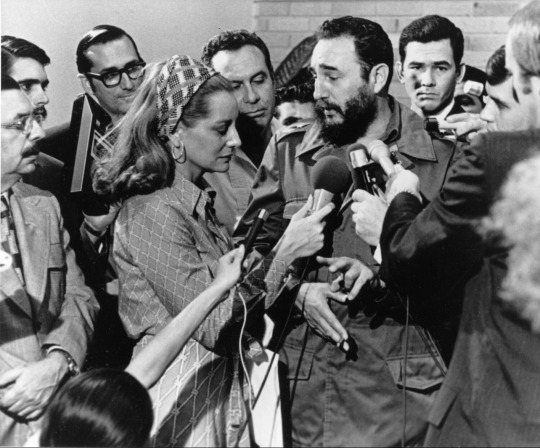
Walters with Fidel Castro in 1975. (Uncredited/Associated Press)
She made history when she was named the first female co-host of NBC’s “Today” show in 1974 and again two years later when ABC tapped her as the first female co-anchor of the network evening news. Walters faced open hostility from her male counterparts in both places, but never let it rattle her publicly, despite being shadowed by deep insecurities that she said lifted only late in her career.
“I was completely unwelcome,” she told The Times in 2008. “They didn’t want a woman, and they didn’t want me.”
Veteran network producer Av Westin, who worked with her at CBS and ABC, said Walters overcame what was a huge hurdle at the time: “To be able to plow through the resistance of a woman being accepted as more than a bit of pretty fluff — she really was the first who did that.”
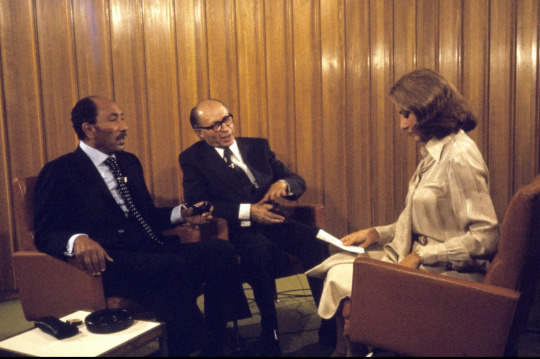
Walters with Anwar Sadat and Menachem Begin. (ABC Photo Archives/Disney General Entertainment Con)
Walters’ ill-matched pairing with evening anchor Harry Reasoner at ABC lasted only two years, and she went on to become a power player at the network as co-host of the prime-time news magazine “20/20,” a post she held for a quarter-century. Her creation of “The View,” the daytime talk show she co-hosted until 2014, gave her another prominent perch.
But Walters was perhaps most familiar to viewers with her “Barbara Walters Specials,” in which she quizzed entertainers such as Elizabeth Taylor, George Clooney and Michael Jackson about their personal lives, drawing them out with a mix of chumminess and relentlessness. Times television critic Mary McNamara said Walters was part confessor, part therapist and succeeded brilliantly at making “emotion newsworthy.”
Her ability to reinvent herself with the times made her a singular figure in the media: an octogenarian deeply immersed in current celebrity culture.
She moved in the same bold-faced social set as the movie stars and political leaders she interviewed, leading some critics to suggest that she pulled her punches in interviews to avoid offending friends. Walters insisted that her personal relationships never got in the way of her job, but was unapologetic about the amiable tone she had with interview subjects in her prime-time specials.

Walters with Monica Lewinsky. (Virginia Sherwood/Disney General Entertainment Con)
“I don’t want them to go away discouraged,” she told the New York Times in 1992.
While proud of the popularity of shows such as “10 Most Fascinating People,” Walters worried at times that the public had forgotten the hard-hitting interviews she did with dozens of world leaders, including Saddam Hussein and Moammar Kadafi. When asked what she hoped to be remembered for, Walters responded: “As a good journalist,” adding: “Not as someone who made people cry.”
Gifted with an innate appreciation of the power of the public confessional, Walters published her own juicy autobiography at age 78 in which she detailed her guilt-ridden relationship with her mentally disabled older sister, the attempted suicide of her father and an affair she had with a married U.S. senator in the 1970s.
“I wanted people to know that … I, who seemed to have this perfect life and this great career and the daughter and the men and so forth, have not had a perfect life by any means,” she told The Los Angeles Times.
Barbara Jill Walters was born in Boston on Sept. 25, 1929, the youngest daughter of Lou Walters, a vaudeville booker-turned-nightclub impresario who created the famed Latin Quarter club in Times Square, and Dena Seletsky, a clerk in a men’s neckwear store. Her older sister Jacqueline had a mild mental disability, which was a source of embarrassment and then guilt for Walters throughout her life.

Walters with Arnold Schwarzenegger. (Virginia Sherwood/Disney General Entertainment Con)
For a time, the family enjoyed a posh lifestyle. Walters spent part of her childhood in a vast penthouse in Manhattan and a pistachio green mansion in Miami, where her father opened a Florida version of the Latin Club. Joseph P. Kennedy Sr., among other power brokers, was a frequent guest. Walters grew accustomed to encountering celebrities backstage.
“I met so many stars: Frank Sinatra, Milton Berle, Sophie Tucker,” she recalled in an interview. “It was very glamorous on the surface, but I knew they had problems and difficulties. So I’ve never been in awe of celebrities. That comes from my childhood.”
Still, Walters said she was a “somewhat lonely child,” in part because her parents kept her and her sister isolated so as not to expose Jacqueline to ridicule. The family was also constantly in a precarious financial state because of Lou Walters’ gambling debts, a situation that riddled his youngest daughter with insecurity for much of her life.
“No matter how high my profile became, how many awards I received, or how much money I made, my fear was that it all could be taken away from me,” she wrote in “Audition,” her 2008 autobiography.
After studying theater at Sarah Lawrence College, Walters worked as a secretary at a New York advertising agency, then got her first television job as a publicist for the local NBC affiliate in New York. Several years later, she was hired as a writer for CBS’ morning show, which was then co-anchored by a young Walter Cronkite and Dick Van Dyke. She made her on-camera debut on that program, replacing a model who failed to show up for a bathing suit segment.

Walters with Patrick Swayze. (Ron Tom/Disney General Entertainment Con)
When Walters was 29, her father’s newest club went bankrupt and he tried to kill himself with sleeping pills. Her first marriage, to hat manufacturer Bob Katz, had recently ended in divorce after three years, and she was left as the sole supporter of her family.
After a stint at a public relations firm, she landed a job as a writer on “Today” in 1961. She occasionally got to do on-air pieces, even covering First Lady Jacqueline Kennedy’s trip to India and Pakistan in 1962.
Walters was made an official reporter in October 1964, taking over for actress Maureen O’Sullivan in the role that had been known as the “Today Girl.” Now that she was in the spotlight, Walters worked with a voice specialist to overcome her difficulty pronouncing Rs, a quirk she said was the remnant of a Boston accent. But after viewers complained she sounded stilted, she gave up trying. (Her distinctive speaking style would later inspire comedian Gilda Radner’s “Baba Wawa” impersonation on “Saturday Night Live.”)
Walters sought to tackle meaty news stories, despite the resentment she encountered from male colleagues. When “Today” host Frank McGee demanded that Walters be limited to “girlie” interviews, she protested. The network president came up with a compromise: McGee could ask the first three questions of newsmakers visiting the studio; Walters, the fourth.
Quietly fuming, Walters sought interviews outside the studio, where McGee had no say, pursuing subjects with handwritten letters. She got an exclusive with President Nixon’s chief of staff, H.R. Haldeman; interviewed the elusive Israeli defense minister Moshe Dayan; and covered Nixon’s historic trip to China as one of only three female reporters in the traveling press corps.
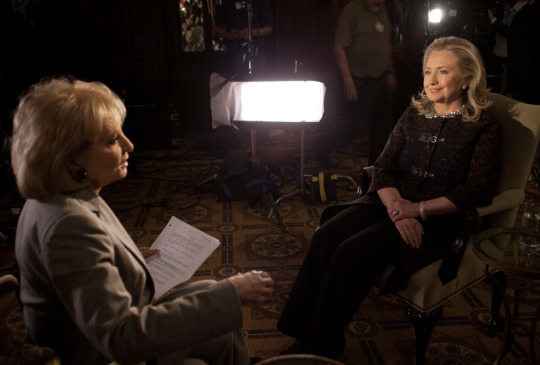
Walters with Hillary Clinton in 2012. (Martin H. Simon/Disney General Entertainment Con)
Despite the attention she brought the network with her reporting, NBC refused to name Walters co-host of “Today” until McGee died of bone cancer in 1974. The appointment of the first female network anchor made the cover of Newsweek.
ABC lured Walters away two years later, promising her a then-staggering $5 million over five years — worth $30.2 million in 2022 dollars — to co-anchor the evening news and do prime-time specials. The press was skeptical of her worth, dubbing her the “million-dollar baby.” She encountered an even icier reception from Reasoner, her co-anchor.
The tension between the two was so palpable on the air that actor John Wayne sent Walters a telegram reading, “Don’t let the bastards get you down.”
“It was very hard,” she recalled in 2008. “I would wipe my eyes before I went out there and put the smile on. But after a while, people realized. It was so uncomfortable watching us that I was beginning to get the sympathy vote, which I didn’t really want.”

Walters with Mike Tyson and Robin Givens. (Robert Maas/Disney General Entertainment Con)
News division President Roone Arledge finally ended the pairing after two years, and Walters survived by fashioning a new role for herself: that of the globe-trotting interviewer. She interviewed Fidel Castro in a patrol boat on the Bay of Pigs and scored a world scoop by landing the first joint interview with Israeli Prime Minister Menachem Begin and Egyptian President Anwar Sadat, infuriating competitors such as Cronkite.
“I’m very grateful that I have that period in my life,” she said. “I think the whole body of my work is enough so that people, I hope, realize that I don’t just do celebrities.”
At times, her career was filled with escapades out of a James Bond movie: A Panamanian dictator tried to romance her. She secretly passed on a message to President Reagan from an Iranian arms dealer involved in the Iran-Contra deal, an act that drew a public reprimand from ABC for violating news division standards.
In 1980, she was named co-host of “20/20,” the prime-time news magazine ABC had created to challenge “60 Minutes.” Walters used the show as a platform to expand her run of exclusive interviews, fiercely competing for scoops, sometimes even with ABC colleagues.

Walters with Katharine Hepburn in 1987. (ABC Photo Archives/Disney General Entertainment Con)
Westin, who served as her executive producer on that show for close to a decade, said the secret to Walters’ success was her over-preparation.
“She really had a lack of self-confidence, believe it or not,” he said. “If she was going to do an interview with a major figure, she would do more research than anyone. She would call around to all her contacts, asking, ‘What questions should I ask?’ She was always concerned her colleagues and critics would find her wanting, and she didn’t want to let that happen.”
Walters brought a lighter tone to her prime-time specials, perching on an elephant with James Stewart, riding behind Sylvester Stallone on a motorcycle and getting a lap dance from Hugh Jackman.
She was unapologetic about using every tool she had to score a big interview. She noted in her 2008 autobiography “Audition” that for all the discrimination she faced in journalism as a woman, it also had its advantages.
“A sought-after male subject chooses you to do the interview in the hope that somewhere along the line, the romantic side — or at least the flirtatious side — will surpass the professional,” she wrote.
In her later years, Walters remade herself as a successful producer of “The View.” The unpredictable back-and-forth of the hosts, particularly during Rosie O’Donnell’s tumultuous tenure on the show, made it water-cooler fodder. It also became a regular stomping ground for political figures seeking to reach female viewers.
Walters officially retired in 2014, but then quickly announced she was “coming out of retirement” to do a special “20/20” interview with the father of Elliot Rodger, the UC Santa Barbara student who killed six people and wounded 14. She continued to do occasional specials. Her last on-air interview was with then presidential candidate Donald Trump in 2015. She was rarely seen in public in recent years.
Walters is survived by her daughter Jacqueline, whom she adopted with her second husband, theatrical producer Lee Guber. They divorced in 1976. Walters’ third marriage, to television producer Merv Adelson, also ended in divorce.
Over the years, she was romantically involved with numerous powerful men, including future Federal Reserve Chairman Alan Greenspan and U.S. Sen. John Warner of Virginia. In her autobiography, Walters revealed that she carried on a two-year affair in the 1970s with Edward R. Brooke, a married U.S. senator and first Black person elected to that body since Reconstruction.
If she had any regret in her life, Walters told The Times, it was that she never kept a diary.
“I still think, ’Oh, the things I’ve heard and forgotten!’ ” she said.
— Matea Gold is a former Times staff writer. Times staff writer Steve Marble contributed to this report.
0 notes
Photo

Matea by MichaelSchnabl
1 note
·
View note
Note
Hey I’m not sure if you saw my request, but could you help me find masculine Jewish names that start with the letter m?
under the cut! apologies if these aren’t very good / are inaccurate / etc, i’m not jewish myself and i basically had to trust google on this one /gen /nm
Maadai / Maad / Maadian / Maadya
Maagan
Maali
Maanin
Maar / Maaravi
Maaseiya
Maath
Maats
Maayan
Maaye
Maaz / Maazia / Maaziah / Maazya
Maazyahu
Maccabee
Maceo
Machau
Machbanai / Machbenah
Machir
Machli
Machlon
Machnadebai
Machol
Machpelah
Machum
Maciej
Madian
Madon
Mads
Maeryn
Maessaï
Magdiel
Magen
Maguide
Mahail
Mahaleleel
Mahaz
Mahir/ Mahira
Mahli
Mahlon / Mahlone
Mahol
Maialen
Maichail
Makaio
Makas
Makis
Mal
Malach / Malachai / Malachi / Malachie /Malachy
Malak / Malakai / Malakhi / Malaki
Malbin
Malcah
Malcham
Malchiah
Malchiel
Malchijah
Malchom
Malkah
Malkam
Malki / Malkiah / Malkiel / Malkiya
Mallaidh
Mallothi
Malluch
Malochai
Mammon
Man
Manaen
Manahethites
Manases / Manasses
Manasse / Manasseh
Mangena
Mannis
Manny
Mano
Manoah
Manoel
Manolo
Manos
Manuel
Maon
Maor
Mara
Mareshah
Marian
Marion
Marisha
Marlin
Marni / Marnin
Marus
Masada
Masai
Mash / Mashe
Mashen
Mashiah
Maskil
Mat
Matai
Matan
Matana / Matane
Matar
Matat
Mate
Matea
Matei
Matej
Mateus / Mateusz
Mathe
Mathea
Matheus
Mathew
Mathia
Mathieu
Mathis
Mati
Matias
Matisse
Matitya
Matityah / Matityahou
Matjasz
Matok
Matous
Matri
Mats
Matson
Matt
Mattan
Mattana / Mattaniah
Mattanyahu
Mattatha / Mattathia / Mattatia / Mattea
Mattenai
Matteo
Matthaios
Matthal
Matthea
Matthew
Matthia
Matthias
Matthieu
Matti
Mattias
Mattithiah
Mattithyahu / Mattitiahou / Mattityahu
Matty
Matvei / Matvey
Matxalen
Matyas
Matz
Mayan
Mayir
Mazi
Mazzy
Maïmone
Meadi
Mearah
Mecherath
Mechoulam
Medad
Medan
Medane
Meged
Mehida
Mehitahelle
Mehoudar
Mehuman
Meier
Meilseoir
Meir
Meira
Meitar
Melatiah
Melchi
Melchi-shua
Melchiah
Melchior
Melchizedek
Melchoir
Melech
Melek
Melekh
Melzar
Memucan
Menache
Menachem / Menachemah
Menaheim
Menan
Menashe
Menashsheh
Menassah
Mendel
Meni
Meoudane
Mephaath
Mephibosheth
Merab
Meraioth
Merari
Meraya
Mercurius
Mered
Meres
Meribbaal
Merkaba
Merodach-baladan
Meron
Meronothite
Meshach
Meshar
Meshulam
Meshullam
Mesobaite
Messiah
Methetabel
Methusael
Methuselah
Mettabel
Meunim
Meyer
Meyshawn
Mezahab
Meïr
Miamin
Mibhar
Mibzar
Micah
Micaiah
Mical
Micha
Michael
Michaelyn
Michal
Micheal
Micheam
Michel
Michelangelo
Michema
Michmach
Michon
Michtam
Mickey
Micole
Midian
Mieze
Migdal
Migdol
Miguel
Mihails
Mihaly
Mijamin
Mika
Mikael
Mikala
Mike
Mikel / Mikele
Mikelis
Mikha
Mikhael
Mikhah
Mikhail
Mikhalis
Mikhayahou
Mikhos
Miki
Mikkel
Mikko
Milaana
Milcah
Mili
Mindel
Minya
Minyamine
Mirit
Mirke
Miron
Misael
Mischa
Misha
Mishael
Misham
Mishraites
Misi
Miska
Mitch
Mitchell
Mithnite
Mitzi
Mivsam
Mivtsar
Mizar
Mizraim
Mleel
Mnason
Moab
Moche
Moeshe
Moises
Moishe
Moishi
Moladah
Molid
Moll
Moloch
Moran
Morane
Mordecai / Mordechai / Mordekhaï / Mordokhay
Mori
Moriah
Moriel
Moselle
Moses
Mosha
Moshe
Mosheh
Mosiah
Mosie
Motel
Motya
Mouchi
Mousa
Mozah
Moze
Mycah
Mychal
Mykhaila
Mykhailo
Myron
11 notes
·
View notes
Text
Chef and the Aesthetics of Multicoding

To bake a Hello World Souffle requires exactly 114 g sugar, 111 ml beaten eggs, 54 ml double cream, and 32 g cocoa powder. Most recipes measure by the number of eggs, rather than their volume in milliliters, and do not opt for a level of specificity appropriate more for a chemistry lab than a kitchen. However, this recipe is not only for cooking, but also serves as a computer program in the Chef language.
Chef is one of the best-known esolangs to embrace multicoding: where content has different meanings when considered in different contexts. The term (as "multiple coding") was coined by Michael Mateas and Nick Montfort in their "A Box, Darkly" (2005), the paper that first introduced many academics to esoteric and obfuscated coding practices. It uses the example of "Jean put dire comment on tap," a phrase that holds very different meanings in French and English. Programs can be multicoded on a few different levels. Malicious programs are sometimes written with a gap between its reading by a human and its actual execution by the machine. In our previous post, we looked at the case of Primify, which multicodes numbers and images. Programs known as polyglots have a single text that holds multiple meanings even to the machine itself, functioning differently when interpreted in more than one programming language.
When Chef appeared in 2003, it joined a slowly growing list of esolangs that are explicitly multicoding, although this term was not one used by their creators (they are usually simply described as "designed to make programs appear to be something else"). Its author, David Morgan-Mar (interviewed here), created the cult esolang Piet the previous year. Where Chef's programs multicode as cooking recipes, programs in Piet (pronounced "Pete") are images, with commands defined by the change in hue or lightness between adjacent pixelly blobs of color, called codels. Shakespeare (created 2001) has as its programs, long, rambling stage scripts. Whitespace (2003) uses only tab, space, and return. In Whitespace, commands are multicoded as what is normally read as their absence. These characters are treated interchangeably by C and C-derived languages, meaning Whitespace programs can be embedded between words in these programs, creating polyglot programs that function in both languages.
There were few precursors for these languages in the early '00s. Previous esolangs like brainfuck and Malbolge had unusual lexicons, but emphasized their puzzle-like logic. Multicoding languages don't generally have unusual logical systems, most are straightforward, procedural languages behind their odd vocabularies. More recent multicoding languages, like AshPaper and bodyfuck, have benefited from these forerunners, learning the lessons of how Shakespeare commands are constructed as dialogue. But at the time Shakespeare was written, it was intended primarily as both joke and provocation. Its creators likely had little expectation that esoprogrammers would continue to work with these languages and learn from them decades later. Otherwise, there would be alternatives to Shakespeare's repetitive "SPEAK YOUR MIND!" command. So it might seem unfair to overly critique their design decisions, but considering Chef's design more deeply can give us insight into how multicoding schemes function and help consider possibilities in multicoding strategies for future works.
READ MORE
9 notes
·
View notes
Link
Here are the top 500 German Names!
[toc]
1. Top 500 German Names
Girls Boys
Emma
Emilia
Hannah / Hanna
Mia
Sofia / Sophia
Lina
Mila
Marie
Ella
Lea
Anna
Clara / Klara
Leni
Lena
Frieda / Frida
Luisa / Louisa
Leonie
Emily / Emilie
Mathilda / Matilda
Charlotte
Ida
Johanna
Amelie
Lia / Liah / Lya
Sophie / Sofie
Lilly / Lilli
Lara
Maja / Maya
Nele / Neele
Greta
Laura
Lotta
Sarah / Sara
Juna / Yuna
Nora
Melina
Paula
Elisa
Pia
Marlene
Victoria / Viktoria
Alina
Julia
Elena
Lisa
Mara / Marah
Mira
Helena
Pauline
Tilda
Luna
Isabella
Maria
Antonia
Finja / Finnja
Anni
Eva
Thea
Elina
Romy
Luise / Louise
Isabell / Isabel / Isabelle
Zoe / Zoé
Fiona
Merle
Josephine / Josefine
Hailey
Elli / Elly
Carla / Karla
Paulina
Martha / Marta
Malia
Lucy / Lucie
Mina
Rosalie
Jana
Emely / Emelie
Milena
Valentina
Carlotta / Karlotta
Maila / Mayla
Theresa / Teresa
Katharina
Magdalena
Annika
Nina
Amalia
Elisabeth
Olivia
Jule
Luana
Liya
Lotte
Emmi / Emmy
Amy
Linda
Ronja
Amelia
Melissa
Leila / Leyla
Stella
Jasmin / Yasmin
Annabell / Annabelle
Alma
Miriam
Chiara / Kiara
Aaliyah / Aliya
Freya
Malina
Liana
Anastasia
Lene
Franziska
Liv
Milla
Ylvi / Ylvie
Alicia
Ava
Rosa
Zoey
Marleen / Marlen
Alessia
Elif
Amira
Aurelia
Lucia
Ela
Kira / Kyra
Aria / Arya
Diana
Selina
Elise
Evelyn / Evelin / Eveline
Ariana
Jette
Marla
Alea
Enna
Lynn / Linn
Helene
Livia
Mariella
Alexandra
Carolina / Karolina
Edda
Tessa
Linnea
Sina / Sinah
Vanessa
Aurora
Vivien / Vivienne
Milana
Cataleya
Talia / Thalia
Eliana
Leana
Malea
Mona
Aylin / Eileen / Aileen / Ayleen
Laila / Layla
Liliana
Alice
Jara / Yara
Jonna
Mathea / Matea
Lorena
Alisa
Carolin / Caroline / Karoline
Nela
Kaja / Kaya / Caja
Julie
Melia
Samira
Alissa / Alyssa
Daria
Giulia
Smilla
Amina
Elsa
Heidi
Lana
Valerie
Ayla
Medina
Zeynep
Henriette
Amilia
Leticia / Letizia
Malou
Annelie
Hilda
Noemi
Selma
Aleyna
Elin
Liara
Lenja / Lenya
Bella
Hedi / Hedy
Levke
Nika
Celine
Svea
Veronika
Celina
Ruby
Fenja
Hermine
Ina
Larissa
Tabea
Felicitas
Jolina / Joelina
Marina
Valeria
Azra
Michelle
Rebecca
Nisa
Annalena
Alva
Elea
Melody
Palina
Flora
Maira / Meyra
Mariam / Maryam
Natalie / Nathalie
Nala / Nahla
Alena
Cleo
Eleni
Malin
Alya
Felina
Florentine
Helen
Lou
Naila / Nayla
Nelly / Nelli
Christina
Käthe
Leona
Alia
Marlena
Tamara
Tara
Angelina
Carina / Karina
Dalia
Hedda
Leia / Leya
Meryem
Anne
Holly
Madita
Fabienne
Jella
Mailin / Maylin
Mathilde
Enya
Kate
Lilia
Sena
Joleen
Clea
Liesbeth / Lisbeth
Fine / Fiene
Lenia
Sonja
Xenia
Eleonora
Melisa
Enni / Enny
Hira
Adriana
Dana
Defne
Lola
Miray
Tamina
Nicole
Asya
Esther
Josie / Josy
Naomi
Cecilia
Claire
Dilara
Selin
Enie
Fritzi
Leonora
Melek
Miley
Wilma
Esila
Esma
Feline
Rieke
Ada
Amara
Cara
Estelle
Gerda
Lilian / Lillian
Viola
Adelina
Janne
Philine
Tiana
Ivy
Juliana
Kimberly / Kimberley
Lieselotte
Malena
Delia
Enisa
Joana / Joanna
Kim
Ellen
Evelina
Felicia
Liyana
Lilith
Liz
Amanda
Anouk
Eleanor
Samantha
Talea
Arina
Dua
Emilija
Eslem
Irma
Maike / Meike
Nike
Rita
Adele
Alisha
Iva
Josefin / Josephin
Margarete
Romina
Ylva
Elaine
Helin
Joline / Joeline
Josephina / Josefina
Madeleine
Nila
Ophelia
Philippa
Abigail
Anja
Melinda
Scarlett
Toni / Tony
Erna
Gloria
Grace
Jade
Jolie
Madlen / Madleen
Marit
Melanie
Tuana
Annemarie
Debora / Deborah
Jenna
Kiana
Liva
Minna
Shirin
Zofia
Chloe
Fatima
Felia
Friederike
Isa
Jasmina
Jolien
Leandra
Nia
Salome
Giuliana
Inga
Josefa / Josepha
Judith
Megan
Mika
Nea
Neyla
Runa
Ruth
Sunny
Tala
Abby
Alba
Amaya
Anisa
Bianca / Bianka
Eliza
Gabriela
Janna
Jessika / Jessica
Maileen / Mayleen
Natalia
Soraya
Verena
Asel
Cassandra / Kassandra
Eda
Elenor
Julina
Kayla
Lilou
Lydia
Maggy
Meva
Naemi
Penelope
Rahel
Violetta
Alara
Caitlin / Caitlyn
Elis
Ilayda
Judy
Juliane
Sila
Vera
Anita
Charlotta
Evi
Henrieke / Henrike
Jamila
Janina
Ria
Sarina
Stina
Zara
Zuzanna
Zümra
Beyza
Cosima
Ema
Florentina
Ines
Jona / Jonah
Kalea
Katerina
Klea
Masal
Milina
Nilay
Skadi
Tarja
Tina
Charlie / Charly
Franka
Hanne
Hilde
Joy
Joyce
Luzi / Luzie
Marisa
Mary
Meta
Minel
Sandra
Sienna
Vaiana
Adea
Cora
Davina
Dorothea
Erika
Femke
Freda
Hafsa
Jamie
Katja
Nova
Patricia
Philomena
Saphira
Saskia
Tiara
Yaren
Alica
Ashley
Betty
Celia
Clarissa
Dina
Elara
Elodie
Emina
Ben
Paul
Finn / Fynn
Leon
Jonas
Noah
Elias
Felix
Luis / Louis
Henry / Henri
Lukas / Lucas
Luca / Luka
Matteo
Emil
Maximilian
Theo
Oskar / Oscar
Liam
Anton
Jakob / Jacob
Max
Leo
Milan
Moritz
Julian
Alexander
David
Carl / Karl
Jona / Jonah
Samuel
Philipp
Niklas / Niclas
Tom
Mats / Mads
Erik / Eric
Linus
Jonathan
Tim
Rafael / Raphael
Leonard
Mika
Aaron
Vincent
Hannes
Levi
Johann
Lio
Jannis / Janis / Yannis
Fabian
Jan
Lennard / Lennart
Till
Benjamin
Valentin
Artur / Arthur
Simon
Johannes
Maxim / Maksim
Constantin / Konstantin
Marlon
Jannik / Yannik / Yannick / Yannic
Adrian
Joshua
Kilian
Nico / Niko
Mattis / Mathis / Matthis
Theodor
Julius
Toni / Tony
Lian
Luke / Luc
Milo / Milow
Mohammed / Muhammad
Fiete
Fritz
Nick
Bruno
Ole
Lenny
Adam
Gabriel
Matti
Phil
Daniel
Pepe
Malte
Florian
Benedikt
Lias
Nils / Niels
Dominic / Dominik
Michael
Ludwig
Lasse
Damian
Sebastian
Levin
Emilio
Carlo
Timo
Franz
Leopold
Jannes
John
Justus
Thilo / Tilo
Luan
Noel
Tobias
Joris
Oliver
Sam
Emilian
Malik
Lennox
Robin
Bennet
Frederik / Frederic
Piet
Elia / Eliah
Jayden / Jaden
Arian
Nicolas / Nikolas
Jonte
Alessio
Eddie / Eddy
Lion
Bela
Richard
Matthias
Miran
Emir
Lars
Friedrich
Enno
Ilias / Ilyas
Joel
Ferdinand
Marc / Mark
Henrik
Silas
Willi / Willy
Ali
Charlie / Charly
Christian
Bastian
Colin / Collin
Kian
Thore
Mailo
Benno
Jaron / Yaron
Jason
Hugo
Lenn
Neo
Tyler / Tayler
Jamie
Leonardo
Josef / Joseph
Michel
Gustav
Lorenz
Yasin
Jasper
Konrad
Elian
Dean
Lionell
Arne
Finnley / Finley / Finlay
Amir
Manuel
Thomas
Leano
Nikita
Nathan
Alex
Tristan
Aiden / Ayden
Marvin / Marwin
Hendrik
Maik / Meik / Mike
Aras
Curt / Kurt
Martin
Yusuf
Andreas
Hamza
Janosch
Xaver
Elija / Elijah
Lino
Connor / Conner
Leonhard
Eymen
Georg
Leandro
Victor / Viktor
Bjarne
Hanno
Marco / Marko
Marlo
Fabio
Jack
Clemens / Klemens
Diego
Magnus
Mick
Korbinian
Can
Ian
Leander
Antonio
Ömer
Titus
Roman
William
Jano
Mert
Tiago / Thiago
Claas / Klaas
Samu
Marius
Nino
Laurens / Laurenz
Sami
Wilhelm
Darian
Henning
Kalle
Keno
Edgar
Deniz
Erwin
Janne
Marten
Omar
Stefan / Stephan
Timur
Ibrahim
Patrick
Caspar
Otto
Ahmet
Albert
Ayaz
Lean
Christopher
James
Rayan
Alessandro
Dennis
Ilay
Kai / Kay
Peter
Alwin
Carlos
Marcel
Brian / Bryan
Dario
Kaan
Nevio
Robert
Ryan
Yunus
Jakub
Logan
Markus / Marcus
Bilal
Gregor
Darius
Hassan / Hasan
Leonas
Mattes
Mirac
Yigit
Danny / Denny
Eduard
Hans
Julien
Nelio
Kerem
Maurice
Rudi
Tammo
Timon
Ilja
Joscha
Junis
Laurin
Nael
Lutz
Mio
Taylor
Armin
Enes
Karim
Mustafa
Alfred
Christoph
Kevin
Mario
Tino
Valentino
Lijan
Romeo
Umut
Amin
Flynn
Ivan
Jonne
Leonidas
Louie
Mikail
Younes
Björn
Danilo
Emanuel
Giuliano
Jarno
Kjell
Mehmet
Milian
Veit
Youssef
Chris
Egon
Nikolai
Dylan
Ensar
Fred
Jon
Musa
Quentin
Ruben
Thies
Thorin
Tommi
Andre
Emin
Josua
Leif
Loris
Lucien
Miguel
Nathanael
Adriano
Alan
Berat
Devin
Jaro
Juri
Adem
Ahmad
Eren
Kiyan
Mahir
Pius
Anthony
August
Davin
Jesse
Miko
Raik
Rune
Semih
Torben / Thorben
Amar
Angelo
Antoni / Antony
Emre
Matei
Quirin
Ricardo / Riccardo
Tjark
Arvid
Aurelio
Bosse
Efe
Francesco
Hector / Hektor
Jeremy
Jesper
Kirill
Ragnar
Tamme
Vito
Damon
Heinrich
Kuzey
Mattia
Miro
Sandro
Edwin
Elio
Etienne
Jari
Jerome
Levian
Lorenzo
Pablo
Selim
Tamino
Ares
Joost / Jost
Kenan
Levent
Santiago
Tian
Tillmann
Abdullah
Andrej
Arik
Azad
Jamal
Kuno
Leno
Merlin
Alexandros
Amon
Ansgar
Arno
Benny
Berkay
Emmanuel
Isa
Iven / Yven
Junes
Mason
Taavi
Taha
Thees
Alparslan
Andrei
Aris
Casper / Kasper
Cedric / Cedrik
Dion
Elijas / Eliyas
Ilian
Issa
Jordan
Lorik
Luciano
Melvin
Pascal
Rocco
Vitus
Atilla / Attila
Dorian
Enrico
Harun
Johnny
Karam
Kasimir
Koray
Marek
Mikael
Miron
Nero
Nilas
Noar
Sascha
Vinzenz
Zayn
Dejan
Eliano
Fridolin
Jake
Lewis
Abel
Arda
Bent
Burak
Dante
Ethan
Georgios
Halil
Igor
Ioannis
Joey
Justin
Kimi
Lazar
Maddox
Marian
Milas
Paco
Angelos
Ari
Damien
Evan
Finjas
Hardy
Hussein
Jarik
Jascha
Kadir
Khaled
2. Top 10 Middle Names for girls
Phoenix
Lane
Alea
Ivory
Ceci
Joy
Doe
Ruby
Briar
June
More ideals for you: Top 500 Arabic Names
From : https://wikitopx.com/name-meanings/top-500-german-names-711969.html
7 notes
·
View notes
Photo

Static Space, photography by Sebastian Kapfhammer for HUF Magazinehttp://hufmagazine.com/static-space-photography-by-sebastian-kapfhammer-for-huf-magazine/
#Carolin Bohn#Denijel Jarak#Irine Cvjetkovic#Matea Acimovic#Michael Oder#Sarah Scherzer#Sebastian Kapfhammer
1 note
·
View note
Text
Beyond 'Bandersnatch,' the future of interactive TV is bright
by David I. Schwartz
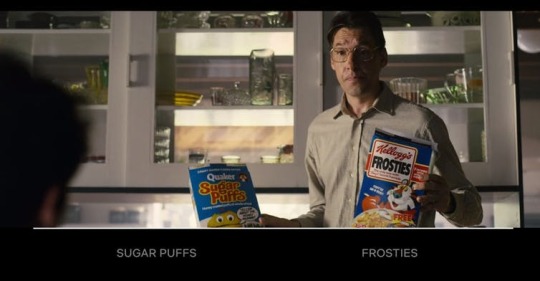
Make a choice to see the next phase of the story. Netflix
Make a choice: Do you want to engage with your media passively or actively?
The December 2018 premiere of Netflix’s “Black Mirror: Bandersnatch” offered consumers a new way to influence the entertainment they’re watching. Netflix has a growing list of choose-your-own-adventure movies. What viewers might see as a simple choice, such as which breakfast cereal a character begins the day with, could affect the whole show’s storyline. There are other choices to make as well – some of which change the plot, and some of which may not.
Viewers aren’t watching these interactive films just once. Rather, they are watching them over and over again to find each ending and post maps of the diverging plot lines. I think I sat on my couch for nearly three hours straight trying to exhaust all of “Bandersnatch’s” choices as it followed a programmer and designer through the process of game development.
I’ve been teaching and researching game design and development since 2001. I see this type of experience not as just the future of entertainment, but as the expansion of a standard method of storytelling that game designers have been using for decades. Netflix is introducing new technology and new audiences to this type of entertainment, but fiction writers have been exploring similar themes for far longer, creating stories of time travel and alternative realities that let people fantasize about redoing decisions in life.
Controlling your own destiny
There is a kind of game made popular by “Dungeons & Dragons” that provides a way to understand and expand what “Bandersnatch” explores. Role-playing games let players pick characters with multiple traits, such as strength, health and special skills, and work together to achieve story-driven goals.
Fans of “The Lord of the Rings” books and movies will recognize the idea of a team of characters with different backgrounds, abilities and motivations, all trying to work together toward a goal. The adventure is not just in whether they achieve the task, but the encounters, mishaps and even battles that happen along the way. The ultimate outcome depends on the choices players make along the way.

Many role-playing games get people together around a computer to explore a collective adventure. AP Photo/Ted S. Warren
Role-playing games started with players gathered around a table, keeping notes on paper and rolling dice to incorporate the role of chance and probability into the adventure. A human game master coordinated everything, keeping track of what was happening and working with players to advance their stories and the overall plot of the adventure.
Early computer games, such as the 1980s-era Infocom text adventures, turned the role of game master over to a game designer, who controlled the choices and their consequences. In the decades since, more powerful computers have let modern digital games offer a great many choices. Teachers have begun to use elements of role-playing games to help students learn.
Illusion of choice
With “Bandersnatch,” Netflix used software to process viewers’ choices and deliver the appropriate video. When watching and “playing,” I wondered if there were too few choices. The show offered only two choices of breakfast cereal, and the viewer couldn’t choose to skip breakfast, make eggs or open the freezer to grab some ice cream. But, there’s a very good reason for these constraints.
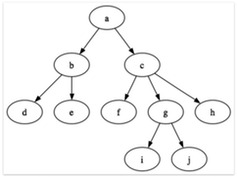
Every story decision requires more writing and more development. Tony Hirst/Flickr, CC BY
I often tell my students that when they’re creating role-playing games, the problem isn’t giving players choices: It’s deciding what happens next. Giving players lots of options is great, and fun – but with every choice the job gets harder. If there are three kinds of ice cream in the freezer, that’s three different sets of video to show vanilla, chocolate and strawberry – and possibly three different scripts, if the choice actually has consequences.
In game design, we call this a “branching narrative,” where every choice spawns as many new branches as there are options, and the tree gets bigger and bigger all the time. A movie with an enormous number of options would require multiple sets, extra time for actors, huge amounts of special effects work, extended production times and increasing budgets.
Such a complex film would also take viewers huge amounts of time to experience. Digital game players can handle this sort of effort by saving their progress and taking a break, returning to resume play hours later, or even days.
With an interactive movie, would a viewer want several days’ worth of watching? I don’t know if anyone has an idea of how long a typical interactive movie experience should last. My three hours on the couch watching “Bandersnatch” seemed about right – and ran through most of the options.
The Netflix producers borrowed from game designers, and the classic “Choose Your Own Adventure” book series, to give viewers the illusion of choices when really the alternatives were limited. My own research recommended the same technique: Allow the players some choices, but bring them back to the main narrative thread at key points.
Future of interactive media
There will be more interactive movies. Netflix has built its own software for “Bandersnatch,” which it can use for other stories too. There are already several addictive interactive kids’ shows, including “Puss in Book: Trapped in an Epic Tale,” “Buddy Thunderstruck: The Maybe Pile” and “Stretch Armstrong: The Breakout.”
Gamers are already familiar with this convergence of film, interactivity and branching narrative. Cinematic video games, like “Indigo Prophecy” and “Heavy Rain,” let players make choices in dialog and other cinematic aspects, all of which alter the endings. An academically published game, “Façade,” is considered important not just for showing that scholarly games can be fun to play, but also demonstrating that academic concepts of branching narrative and story can create meaningful play: The player visits a couple’s apartment, and depending on where the player moves and what the player says, the couple reacts in different ways.

Engaging with a couple on the rocks. 'Façade,' by Michael Mateas and Andrew Stern., CC BY-ND
I anticipate different genres of shows will explore interactive formats. Imagine playing through historical fiction where you can choose to execute Marie Antoinette or not. I also expect viewers will be able to make their choices in different ways than just pressing buttons on their remotes – perhaps by using voice recognition on their phones.
If artificial intelligence and machine learning systems get better at telling stories, viewers might even be able to suggest new possible choices, with the resulting content generated on the fly while people watch. Of course, there’s a strong overlap with virtual reality, offering immersive escapism, which is, in my experience, a key goal of interactivity.
In the meantime, “Bandersnatch” fans who want to continue exploring choosing their own adventures to direct a story can look for local gaming groups and game stores. “Dungeons & Dragons” and “HackMaster” are regaining popularity lately. So is live-action role-playing, in which people physically act out their fictional encounters. In these environments, players can ask “what if” without running into the limitations of software development and movie production teams. Human players can engage in the full extent of their imagination without any illusion of choice.

About The Author:
David I. Schwartz is Associate Professor of Interactive Games and Media at the Rochester Institute of Technology
This article is republished from our content partners at The Conversation under a Creative Commons license.
20 notes
·
View notes
Text
Ok, so...
Why is there no fanficrion for Façade??? Y’know, the game made in 2005 by Michael Mateas and Andrew Stern?? Did everyone forget about it??? Not even a single fanfiction has them. Maybe I’m wrong, maybe I’m right. And if there is, someon plEASE SEND ME A LINK. I CAN’T LIVE WITHOUT MY GRACE.
1 note
·
View note
Text
Demonstration: Interactive Drama Façade
Michael Mateas and Andrew Stern


1 note
·
View note
Text
Design Patterns for Casual Creators
Instant feedback: mental simulation isn’t as good as direct manipulation & reflection-in-action. This allows users to discover patterns and affordances in their possible changes.
The Chorus Line: seeing creations in multiple contexts to make subtle differences and similarities easier to spot.
Simulation and approximating feedback: use tech to simulate audience feedback, e.g. how a human reader would evaluate a story or calculating gameplay traces, to give creator a sense of progress
Entertaining evaluations: Simulated critics can be pleasurable unto themselves.
No blank canvas. Provide a starting shape or suggest challenge. The first move is merely to choose whether to accept or discard the prompt.
Limiting actions to encourage exploration: Different modes have different possibilities, or build a pacing mechanism to scaffold understanding of possibility space.
Mutant shopping: suggest alternatives to browse or edit
Modifying the meaningful: Higher level modifications are more fun to do than small ones.
Saving and sharing: Share data using existing platforms.
Hosted communities: share, annotate, and tag creations while showing ancestry and notify original creator
Modding, hacking, teaching: let the community expand the boundaries of the possibility space
Kate Compton and Michael Mateas, 2015
0 notes
Text
#5yrsago Collaborative critical study of one-line BASIC program written for the Commodore 64

Nick sez,
Remember those BASIC programs you typed into your C64?
Now there's a book written about one.
And the program is only 1 line.
And 10 people wrote this book. As one.
And they're not lunatics but teach at MIT and USC and other fancy places.
And they even wrote programs to study it.
10 PRINT CHR$(205.5+RND(1)); : GOTO 10 is a book of Critical Code Studies that looks at the code and culture of a 1-line program that ran on the Commodore 64. This book uses that 1-liner to explore BASIC programming culture in the 1980s and to reflect on its role in inspiring programmers to take the next step.
By Nick Montfort, Patsy Baudoin, John Bell, Ian Bogost, Jeremy Douglass, Mark C. Marino, Michael Mateas, Casey Reas, Mark Sample and Noah Vawter
https://boingboing.net/2012/11/26/collaborative-critical-study-o.html
10 notes
·
View notes